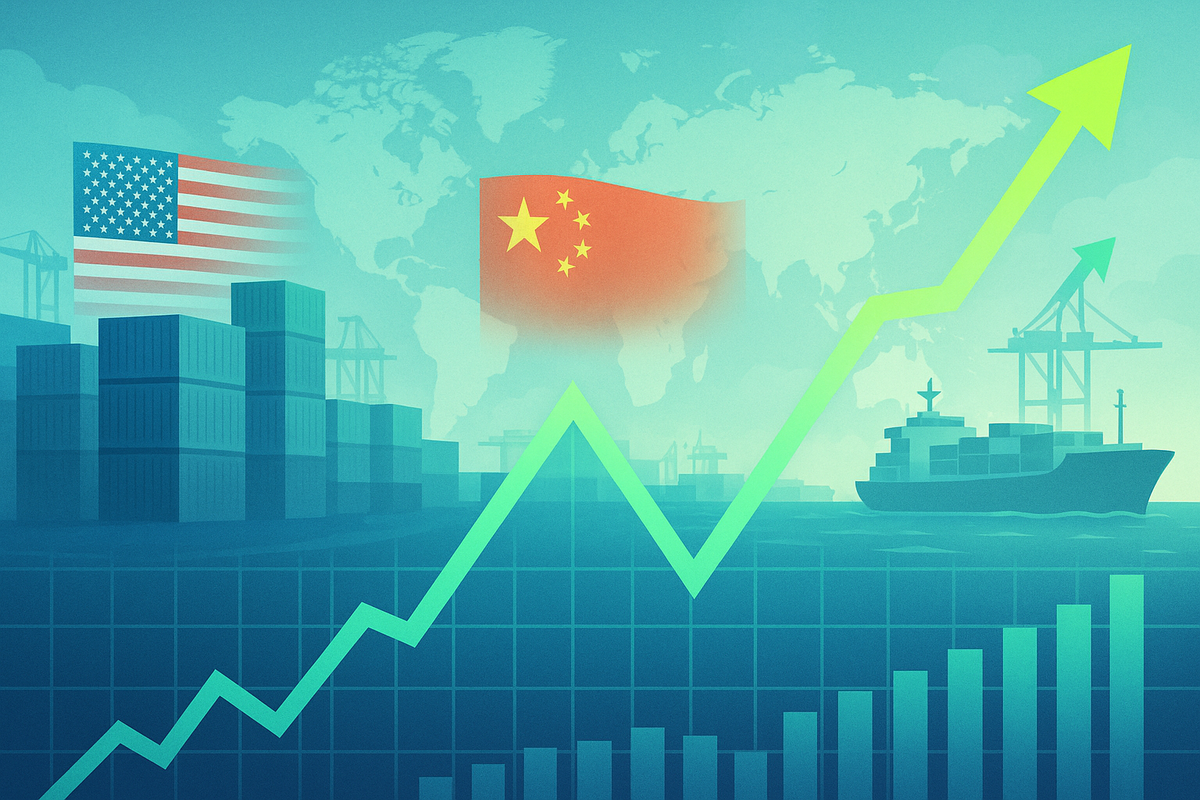
The specter of a full-blown trade war, which has loomed large over global financial markets for years, appears to be receding, at least for now. Investor concerns regarding the impact of tariffs, particularly those between the United States and China, have reportedly subsided, contributing significantly to a recent and robust market rebound. This shift in sentiment marks a notable departure from the anxieties that gripped markets earlier in the year, signaling a renewed appetite for risk among investors.
This newfound optimism comes amidst ongoing developments in U.S. trade policy, including the imposition of higher import taxes on certain goods and the highly anticipated extension of the 90-day tariff truce between the world's two largest economies. While the underlying trade tensions remain, the market's reaction suggests a belief that a more catastrophic escalation has been averted, at least in the short term, allowing investors to focus on other economic fundamentals.
A Cautious Calm: How Tariff Fatigue Fueled a Market Surge
The recent stock market rebound, with major indices like the S&P 500 and Nasdaq Composite nearing or achieving record highs, is a direct consequence of a perceived easing in tariff-related anxieties. What began as a period of volatility and a market decline in early April 2025, triggered by the introduction of new tariff policies, has given way to a resurgence driven by a combination of factors, not least of which is a shift in investor focus.
Initially, tariffs sparked considerable apprehension, leading to a downturn in the stock market. However, a recent survey indicates a notable evolution in investor concerns, with a greater preoccupation now directed towards broader economic indicators and the Federal Reserve's monetary policies, including potential interest rate cuts. This "tariff fatigue" suggests that while the economic impact of current and impending tariffs remains uncertain, the immediate fear of an escalating trade war has diminished. Despite a temporary rollback of some tariffs, the overall effective U.S. tariff rate is still expected to stabilize in the 15-20% range, a level significantly higher than initially anticipated and representing a substantial "tax" on the U.S. economy. This elevated tariff environment is projected to lead to higher prices and a slowdown in global economic growth, though a global recession is not widely anticipated.
The current US-China trade truce, extended for 90 days as of August 2025, is largely perceived as a tactical pause rather than a fundamental shift towards a permanent resolution. While the initial announcement of reduced reciprocal tariffs (from 145% to 30% for the US and 125% to 10% for China) led to an immediate positive reaction in public markets, including a climb in the S&P 500 (SPX) and Nasdaq (IXIC), it offers limited long-term clarity for private equity investors and dealmakers. The sentiment surrounding the truce is one of cautious optimism, providing temporary relief and a window for market stabilization. However, underlying structural risks, geopolitical tensions, and technological disputes remain unresolved, suggesting that this is a "fleeting reprieve" rather than a definitive end to trade uncertainties.
Navigating the Trade Winds: Winners and Losers in a Tariff-Adjusted Landscape
The ebb and flow of tariff developments have created a distinct landscape of winners and losers across various industries and companies. As investor concerns about a full-blown trade war subside, certain sectors are poised to benefit, while others continue to face headwinds.
Companies heavily reliant on global supply chains, particularly those importing raw materials or components from tariff-affected regions, have borne the brunt of these trade policies. Automakers like General Motors (NYSE: GM), Ford (NYSE: F), and Toyota (NYSE: TM) have faced significant cost increases due to tariffs on imported steel, aluminum, and auto parts. General Motors, for instance, projected a tariff hit of up to $5 billion for 2025, while Ford anticipated $3 billion in revenue costs. Similarly, consumer electronics giants such as Apple (NASDAQ: AAPL) and Sonos (NASDAQ: SONO) have seen rising costs for components and finished products. Apple reported $800 million in tariff-related costs in one quarter, with expectations for this to rise. Sonos, a popular audio device maker, even announced price increases due to higher reciprocal tariffs on products from Vietnam and Malaysia. Retailers like Walmart (NYSE: WMT) and Target (NYSE: TGT), as large-scale importers of consumer goods, have also warned that higher tariffs would necessitate price increases on a wide range of items.
Conversely, domestic industries and companies with strong local supply chains have found themselves in a more advantageous position, or have successfully mitigated the negative impacts. U.S.-based steel and aluminum producers, such as Nucor Corporation (NYSE: NUE) and Steel Dynamics (NASDAQ: STLD), have benefited significantly as tariffs on imported materials increased the cost of foreign alternatives, boosting demand for domestically sourced products. Similarly, domestic agriculture and food production companies, including Archer Daniels Midland (NYSE: ADM) and Tyson Foods (NYSE: TSN), could see a boost from increased tariffs on imported agricultural products, making domestic sourcing more competitive.
Many companies have also implemented strategic pivots to mitigate tariff impacts. Supply chain diversification and relocation have become key strategies. WD-40 (NASDAQ: WDFC), for example, decentralized its supply chain to source raw materials and manufacture products closer to its customers. Chinese firms, under pressure from U.S. tariffs, have relocated portions of their production to third countries to obtain new country-of-origin designations and avoid additional duties. Even large automakers like Ford and General Motors have re-evaluated their production strategies, with some shifting production to countries unaffected by tariffs or increasing reliance on local suppliers. Price adjustments, operational efficiency improvements, and even packaging alternatives, as demonstrated by Coca-Cola (NYSE: KO) switching from cans to plastic bottles to avoid higher metal costs, have also been employed as mitigation strategies.
Broader Implications: Reshaping Global Supply Chains and Trade Dynamics
The ongoing tariff developments and the market's reaction to them are not merely isolated events; they are indicative of broader industry trends and have significant implications for global trade dynamics, regulatory frameworks, and competitive landscapes. The "tariff fatigue" observed in investor sentiment, while contributing to a market rebound, also underscores a deeper, more fundamental shift in how businesses and governments approach international commerce.
One of the most significant broader implications is the acceleration of supply chain restructuring. Tariffs have disrupted established global supply chains by increasing costs for imported goods, leading to higher logistics expenses and squeezing profit margins. This pressure is encouraging businesses to diversify their supply chains, explore new markets and suppliers, and consider "reshoring" or "nearshoring" production closer to end markets, even if it means higher operational costs. This shift prioritizes resilience and geopolitical stability over pure cost savings, a fundamental change from the cost-optimization focus of previous decades. The uncertainty caused by tariffs also impacts demand forecasting and inventory planning, leading companies to pause or cancel orders.
The impact on innovation is more complex. While some argue that tariffs can spur innovation by forcing companies to find creative ways to replace imported inputs or invest in domestic industries and new technologies, others contend that tariffs reduce incentives for future innovation. By fragmenting markets and reducing expected sales, tariffs can decrease the justification for investing in research and development (R&D) and expensive manufacturing plants, potentially hindering long-term technological progress and economic growth. Industries shielded by tariffs may become less efficient and innovative over time, falling behind international competitors.
From a regulatory and policy standpoint, tariffs challenge established international trade norms and often bypass or weaken the World Trade Organization (WTO) dispute resolution mechanisms. This can lead to complaints against the imposing country and potentially undermine multilateral trade institutions. The use of tariffs also signals a broader global trend towards protectionism and a re-evaluation of globalized manufacturing, emphasizing "fair" trade, restoring domestic industrial bases, and strengthening national security, rather than purely free trade. Governments are responding with retaliatory tariffs, support programs for affected businesses, market diversification efforts, and legal challenges at the WTO.
Historically, trade disputes have often led to economic downturns, retaliatory cycles, and sometimes even broader political or military conflicts. The Smoot-Hawley Tariff Act of 1930, for example, sharply raised U.S. tariffs and is widely considered to have worsened the Great Depression by leading to widespread retaliatory tariffs and a plummet in U.S. exports. While the current situation has not escalated to that degree, these historical precedents serve as a stark reminder of the potential for unintended consequences and the importance of careful navigation in trade policy.
What Comes Next: Navigating a Shifting Trade Landscape
The current market rebound, fueled by subsiding tariff anxieties, offers a glimpse into a potentially more stable, albeit still complex, trade environment. However, the underlying structural issues that led to the imposition of tariffs remain, suggesting that the current truce is a temporary reprieve rather than a permanent resolution.
In the short term, the extension of the 90-day tariff truce between the United States and China provides a crucial window for negotiations. The market will be closely watching for any concrete progress towards a more comprehensive trade agreement. A successful negotiation could lead to further tariff reductions, providing a significant boost to global trade and economic growth. Conversely, a breakdown in talks could reignite trade tensions, potentially leading to renewed tariff increases and a return of market volatility. Companies that have diversified their supply chains and explored alternative sourcing options will be better positioned to weather any renewed disruptions.
In the long term, the tariff developments are likely to accelerate the ongoing trend of supply chain regionalization and diversification. Businesses will continue to prioritize resilience and risk mitigation over pure cost optimization, leading to a more distributed and less centralized global manufacturing footprint. This could create new market opportunities for countries and regions that offer stable political environments, competitive labor costs, and robust infrastructure. Furthermore, the emphasis on domestic production and national security considerations in trade policy is likely to persist, potentially leading to increased government support for strategic industries and technologies.
Investors should closely monitor the progress of trade negotiations, the evolution of global supply chains, and the policy responses of governments. The "tariff fatigue" that has contributed to the recent market rebound could quickly dissipate if trade tensions resurface. Companies that demonstrate adaptability, innovation in their supply chain management, and a clear understanding of the evolving geopolitical landscape will be best positioned to thrive in this new era of global trade.
Conclusion: A Fragile Equilibrium in the Global Economy
The recent market rebound, driven by a subsidence of tariff anxieties, marks a significant moment in the ongoing saga of global trade. While the immediate threat of a full-blown trade war appears to have receded, the underlying complexities and structural issues that led to the imposition of tariffs remain. This creates a fragile equilibrium in the global economy, where cautious optimism is tempered by the lingering potential for renewed trade tensions.
The key takeaway from this period is the profound impact that trade policy can have on financial markets and corporate strategies. Companies that have been nimble in adapting their supply chains, diversifying their sourcing, and exploring new markets have demonstrated greater resilience. Conversely, those heavily reliant on traditional, centralized global supply chains have faced significant headwinds. The "tariff fatigue" among investors suggests a desire to move beyond the constant uncertainty of trade disputes and focus on broader economic fundamentals, such as interest rates and corporate earnings.
Moving forward, investors should remain vigilant. While the current truce offers a welcome respite, it is crucial to recognize that a permanent resolution to trade disputes is not yet guaranteed. The ongoing negotiations between the U.S. and China will be a critical determinant of future market sentiment. Furthermore, the broader trend towards supply chain regionalization and diversification is likely to continue, reshaping global manufacturing and trade flows for years to come. Companies that embrace these changes and proactively build more resilient and adaptable business models will be best positioned to navigate the evolving landscape of international commerce. The lasting impact of this period will likely be a more cautious and strategic approach to globalization, with a greater emphasis on national interests and supply chain security.





